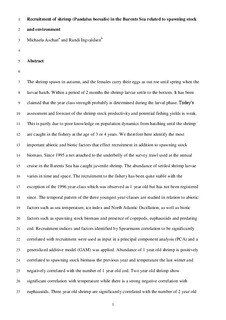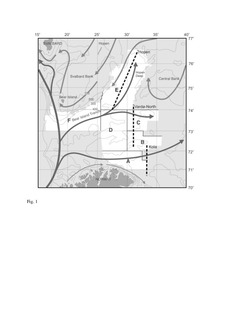| dc.description.abstract | The shrimp spawn in autumn, and the females carry their eggs as out roe until spring when the larvae hatch. Within a period of 2 months the shrimp larvae settle to the bottom. It has been claimed that the year-class strength probably is determined during the larval phase. Today's assessment and forecast of the shrimp stock productivity and potential fishing yields are weak. This is partly due to poor knowledge on population dynamics from hatching until the shrimp are caught in the fishery at the age of 3 or 4 years. We, therefore, here identify the most important abiotic and biotic factors that affect recruitment in addition to spawning stock biomass. Since 1995, a net attached to the underbelly of the survey trawl used at the annual cruise in the Barents Sea has caught juvenile shrimp. The abundance of settled shrimp larvae varies in time and space. The recruitment to the fishery has been quite stable with the exception of the 1996 year-class, which was observed as 1-year-olds but has not been registered since. The temporal pattern of the three youngest year-classes is studied in relation to abiotic factors such as sea temperature, ice index and North Atlantic Oscillation, as well as biotic factors such as spawning stock biomass and presence of copepods, euphausiids and predating cod. Recruitment indices and factors identified by the Spearmann correlation to be significantly correlated with recruitment were used as input in a principal component analysis (PCA) and a generalized additive model (GAM) was applied. Abundance of 1-year-old shrimp is positively correlated to spawning stock biomass the previous year and to temperature of the previous winter, and negatively correlated with the number of 1-year-old cod. Two-year-old shrimp show significant correlation with temperature, whereas there is a strong negative correlation with euphausiids. Three-year-old shrimp are significantly correlated with the number of 2-year-old shrimp the previous year but negatively correlated to temperature at sampling time. This is probably due to less overlap with the main predator cod when cold. Ricker functions indicate an increased density-dependent mortality with age. When predicting the recruitment of shrimp to the fishery, the spawning stock biomass, the abundance of cod and euphausiids, as well as the temperature should be included. | en |

